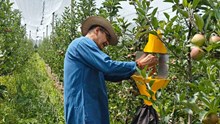
Bael is more than just a fruit tree in India. It is a part of our traditions, our health remedies, and even our worship. Known for its trifoliate leaves, which resemble Lord Shiva’s trishool, the bael tree holds a sacred place in temple rituals. Its fruits have been used for centuries in ayurvedic medicine, cooling drinks, and home remedies for digestion and immunity.
For farmers, bael offers a valuable opportunity because it is hardy, long-lived, and requires less water compared to many commercial fruit crops. The Central Institute for Subtropical Horticulture (CISH) has introduced a new variety called CISH-Bael-2, which is gaining attention for its high pulp content and excellent taste. With 61.32 percent pulp, low seed content, and high nutritional value, this variety promises better returns for growers and more uses for processors.
Key Features of CISH-Bael-2
CISH-Bael-2 has been developed from open-pollinated seedlings. The trees are of dwarf height with a dense canopy, making them easier to manage. Fruits mature in April and May, weighing around 2.25 kg each and turning bright yellow when ripe. The thin shell allows easy cracking, revealing attractive orange-yellow pulp with very low mucilage and seed content.
Nutritionally, the pulp is rich in total soluble solids, natural sugars, carotenoids, and vitamins such as vitamin C (ascorbic acid), riboflavin, thiamine, and niacin. It also contains valuable compounds like marmelosin and psoralen, which are linked to health benefits. Compared to older varieties like NB-9 and NB-16, CISH-Bael-2 offers better pulp recovery and higher nutrient levels, making it ideal for juice, squash, and health supplements.
Suitability and Climate Adaptability
One of the biggest strengths of bael is its ability to grow in challenging conditions. CISH-Bael-2 thrives in subtropical climates with hot summers and mild winters. It can withstand temperatures from 7 °C to 48 °C and grows well up to altitudes of 1,200 meters. The variety can tolerate sodic soils, saline conditions, and pH ranges from 6.0 to 8.5. This makes it suitable for cultivation even on marginal or wastelands where other fruit trees fail.
Planting and Propagation
Propagation is commonly done from seeds, but for maintaining varietal quality, budding or grafting is recommended. Seeds are usually sown in raised beds in June, and seedlings are ready for budding after one year. Patch budding between June and July shows a success rate of up to 90 percent.
For orchard establishment, pits of one cubic meter are dug at 8 × 8 meter spacing in April–May, filled with farmyard manure, neem cake or bone meal, and soil amendments if necessary. In water-scarce regions, pitcher or drip irrigation is effective for establishing young plants. Once mature, bael trees need little or no irrigation.
Orchard Management Practices
Young bael plants benefit from regular irrigation every 10–15 days in summer and monthly in winter. Mulching with paddy straw or sugarcane trash helps retain moisture and control weeds. Training the young tree to an upright form ensures strong framework development, with four to six well-spaced branches.
Nutrient management starts with 5 kg FYM and small doses of nitrogen, phosphorus, and potassium in the first year, gradually increasing to 50 kg FYM and higher doses for mature trees. Zinc and boron supplements can help prevent deficiencies and reduce fruit cracking.
Pest and Disease Management
CISH-Bael-2 is generally resistant to major pests and diseases. However, occasional issues like canker and gummosis can be managed with copper fungicides and streptomycin sprays. Leaf-eating pests can be controlled with recommended insecticides like Rogor. Maintaining orchard hygiene and proper moisture levels reduces most problems.
Harvesting and Yield
CISH-Bael-2 starts bearing fruit 4-5 years after planting. A mature tree (10-15 years old) can yield 60–80 fruits, each weighing more than 2 kg. The high pulp content ensures better returns for processors. For fresh markets, harvesting at the color-break stage ensures good shelf life and better quality.
Economic and Processing Potential
With a pulp percentage of over 61 percent and high natural sweetness, CISH-Bael-2 is highly suitable for making juices, jams, candies, and health drinks. The nutraceutical industry values it for its antioxidant and medicinal properties. Farmers can get better prices in both fresh and processed markets. In many regions, high-quality bael pulp can sell for Rs. 60–80 per kg, and value-added products fetch even more.
CISH-Bael-2 offers a perfect combination of tradition and technology. It is rooted in India’s cultural and medicinal heritage but also fits modern demands for quality, yield, and processing suitability. With its high pulp content, nutritional richness, and ability to grow in difficult conditions, it is a variety that can bring reliable income for farmers while supporting health-focused industries. By choosing CISH-Bael-2, growers can invest in a crop that is both spiritually significant and economically rewarding.
















